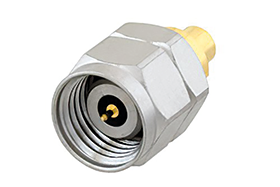

There has been a general trend of radio and sensing applications shifting to higher frequencies, either to avoid interference due to the growing use of RF and microwave spectrum or to take advantage of the growing accessibility of millimetre-wave hardware. This is true for consumer, industrial, military, aerospace and satellite communications applications alike.
Regardless of the cause, the result is an increased need for millimetre-wave interconnects including coaxial cable assemblies, connectors and adaptors, as well as waveguide interconnects. Also, the relatively small size of millimetre-wave hardware compared to RF and even microwave hardware means that there is often a need for even more compact interconnect solutions, such as probes and planar transmission lines (microstrip, stripline, coplanar waveguides, slotlines, etc).
There are several phenomena that come into play at millimetre wavelengths that are often ignored or are only a minor consideration at lower frequencies. Some of these phenomena are skin effect, undesired transmission modes and higher RF losses from dielectrics/conductors. Compounding this is the fact that transmission lines and interconnects are generally geometrically proportional to the frequencies at which they operate. For instance, larger coaxial connectors have a maximum cut-off frequency that is a function of the spacing and dimensions of the inner and outer conductor. This cut-off frequency doesn’t necessarily mean that coaxial connectors are not carrying the higher-frequency signal energy, it just means they are no longer operating according to specification (due to the other transmission modes produced by higher-frequency signal components).
Other considerations are power handling and breakdown voltage. As millimetre-wave interconnects are subject to higher RF losses and smaller conductors and geometries are often used, the power handling and breakdown voltage for these interconnects is usually lower than interconnects designed for lower frequencies. This can be a compounding issue, as the higher RF losses mean that less power can be injected into a system and more power is lost over the length of an interconnect, which results in a proportionally lower effective maximum transmission range.
This is why waveguides are often used as the choice of interconnect for many millimetre-wave applications. Waveguide interconnects generally have higher power handling and lower loss at the same frequencies as coaxial or some planar transmission lines. However, as surface finish becomes a significant component of RF losses at millimetre-wave frequencies, it is important to properly machine or coat conductive surfaces. Hence, for millimetre-wave interconnects used in critical or sensitive applications, the conductors are often coated with precious metals, especially gold due to its corrosion resistance and superior conductivity. High RF losses in millimetre-wave interconnects also come from dielectrics, which makes dielectric choice an extremely important aspect of millimetre-wave design.
Another reason that millimetre-wave applications are often designed with waveguide interconnect or specialised cable assemblies is to address the challenge of an operator making the physical connection. With RF and microwave coaxial, for instance, an operator with some skill and experience can make good RF connections without special tooling. However, at millimetre-wave frequencies the size and tolerance of the connectors and assemblies often dictate the need for precision machine assembly.
Even connecting millimetre-wave coaxial connectors together may be challenging for some, which is why precision indexed cable assemblies are becoming increasingly common. Another reason for the growing use of these specialised cable assemblies is to be able to accommodate many more RF interconnections in the same or smaller connector footprint.
| Tel: | +27 21 555 8400 |
| Email: | [email protected] |
| www: | www.rfdesign.co.za |
| Articles: | More information and articles about RF Design |

© Technews Publishing (Pty) Ltd | All Rights Reserved